As tiny as they may be, sewing needles find so many applications. From general sewing, applique making, beading, quilting, darning, basting to pleating, you can create anything if you have the right needle.
But can one sewing needle do all we have listed above? Are sewing needles universal?
Not all sewing needles are universal. Sewing needles come in different sizes, types, and shapes. Most types have special functions, but there is the universal type, which can be used on practically all domestic sewing machines.
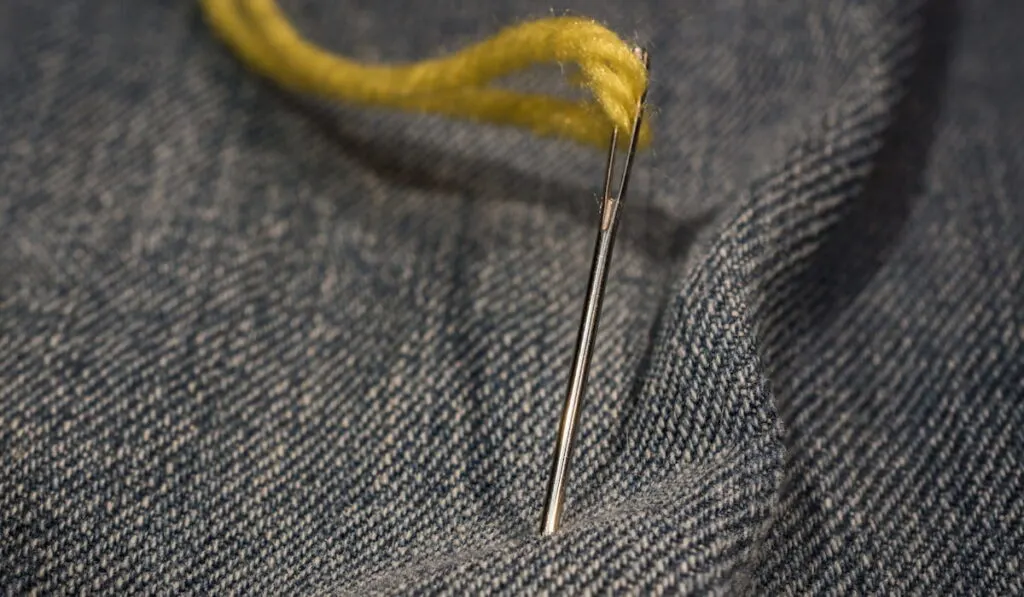
So when you want to buy a sewing needle, what should you look out for? How do you choose the right one? Well, we answer these questions and much more in the paragraphs below.
Are Sewing Needles Universal
The universality of a sewing needle depends on its physical form. Parts of the needle such as the eye, the scarf, the tip/point, the shaft, and the shank will determine if what you have is universal or not.
If the tip of your needle is slightly rounded, the scarf is a bit elongated, and the shank has a flat face, then what you have is a universal needle.
One great thing about universal needles is that you can use it on many types of fabric. But when it comes to medium to heavy fabric, you may have to consider the size of the universal needle you are using.
For instance, if you intend to sew jeans, you should consider a needle size of 90/14 or higher.
But as we said in the introduction, not all sewing needles are universal. So let’s take a look at the other types of needles.
Types of Sewing Needles
So, we’ll be talking about the different types of needles based on their function and based on how they are used.
Some sewing needles are used on machines, while some are used with the hands. We will be looking at machine needles, hand-sewing needles, and their functions.
Machine Needles
Universal Needles
As described above, universal needles have slightly round tips and flat-faced shanks. They are the most used type of sewing needle, so it should not be hard to imagine why they are called universal needles.
You can use universal needles on many types of fabrics, including woven, knit, and synthetic ones. But in some cases, using the needles made for certain types of fabric is better. All-purpose threads like cotton, silk, and polyester are most-fitting for universal needles.
Stretch Needles
Stretch needles have more rounded tips compared to universal needles. So, instead of piercing the fabric, it creates a path between the threads. As the name hints, stretch needles are very suitable for elastic materials. One unique feature of this type of needle is the scarf.
The scarf is a part of stretch needles that allows extra space for your machine’s hook to pass by. With this extra space, you will not have missed stitches as you sew. So, if you intend to work on silk jersey, spandex, or lycra, stretch needles would be perfect.
Some of the best types of thread you can use with stretch needles are polyester threads and cotton-wrapped polyester threads.
Sharps Needles
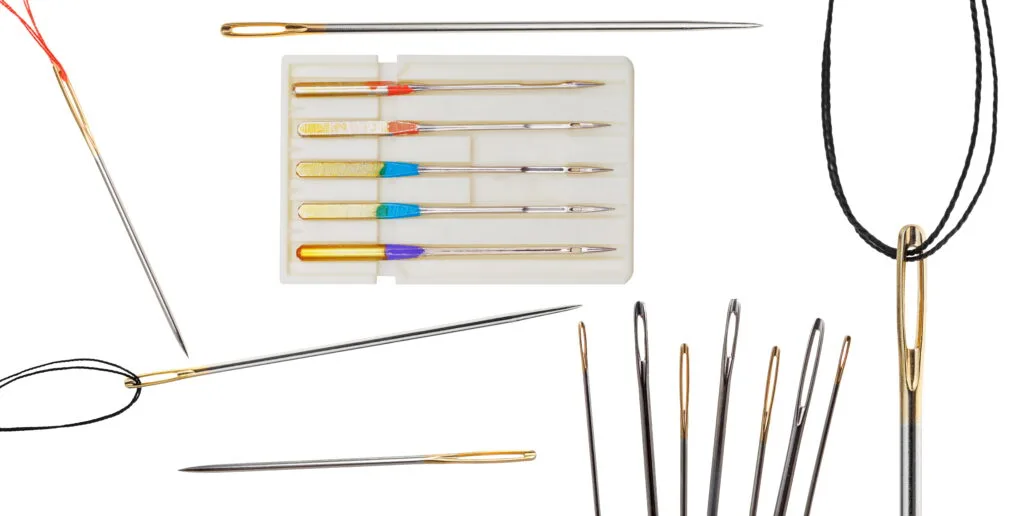
Sharps needles are greater for woven fabrics such as microfiber, synthetic leather, and silk. You can also use these needles for quilting and making appliques.
Sharps needles are sharper and slimmer than universal needles, and they have stronger shafts. So, they work very well when you have to work with multi-layered fabric.
Ballpoint Needles
The tip of ballpoint needles is more rounded than stretch and universal needles. They do not pierce the fabric. Rather, they go between the threads.
Ballpoint needles do well on knits, fleece, and interlocks because they do not snag or ladder. Polyester and polyester-cotton threads are the best threads for this type of needle.
You should also consider the size of the needle when choosing a thread. Small-sized needles should use finer threads, while larger needles should use thicker threads.
Jeans Needles
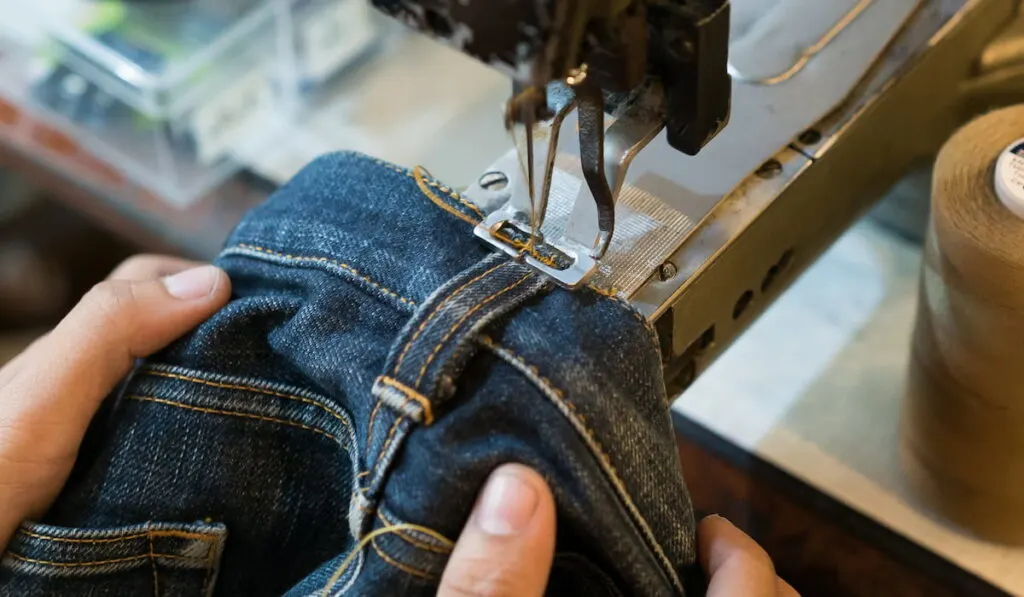
It’s not hard to guess what jeans needles are used for. Yes, they are used for jeans. But besides denim materials, they will also work for other dense materials such as canvas, heavy linens, and heavy twills.
Jean needles come with a reinforced yet sharp eye. This allows them to go through heavy materials without breaking or bending. Heavy threads and polyester threads are suitable for use with jean needles.
If you notice skipped seams while sewing a jeans needle, you should try a larger needle for better results. You could also reduce the speed at which you sew.
Quilting Needles
Quilting needles are mainly used for designing the surface of fabrics. They work for quilting, stippling, and piecing. They come with strong shafts and sharp tips, and this makes it easy for them to go through fabrics with many layers.
Due to their shortness, quilting needles allow quick and uniform stitching. The small-sized types are easier to use than the larger ones, but with time, you’ll get used to the larger ones.
Leather Needles
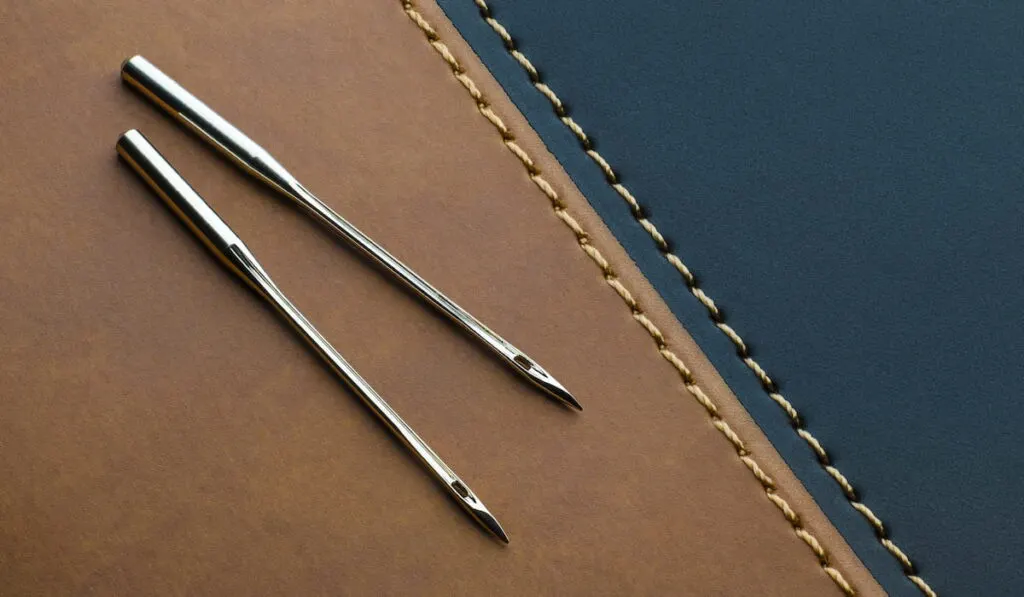
Leather needles have a unique point shaped like a triangle. This allows them to make neat holes in non-woven fabrics such as natural leather and vinyl.
You should avoid using leather needles on synthetic leather because they can cut rather than pierce the leather. Sharps or Microtex needles are more suitable for synthetic leathers.
Metallic Needles
Metallic needles are also used to create designs on fabrics. They are great for embroidering knits and woven fabrics. They have a large eye, so your thread will not shred as you sew. Also, with the size of the needle eye, using fancy thick threads is easy.
Wing Needles
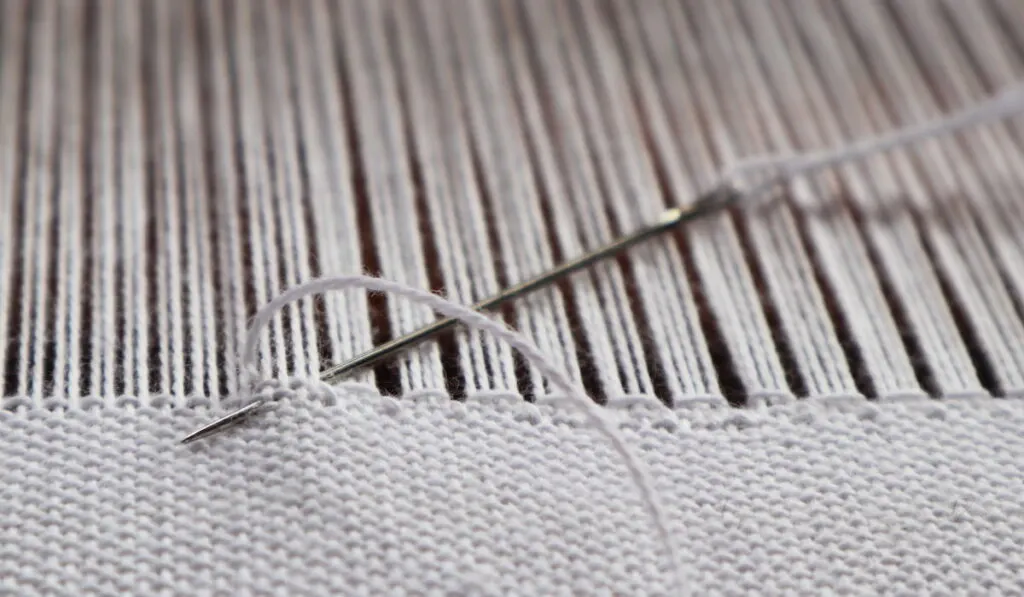
Wing needles are also called hemstitch needles and are used for hemstitching. They are suitable for fabrics made of cotton or linen.
The needles come with a fin on each side, hence the name wing needles. The fins make holes as the needle runs through the fabric.
Twin and Triple Needles
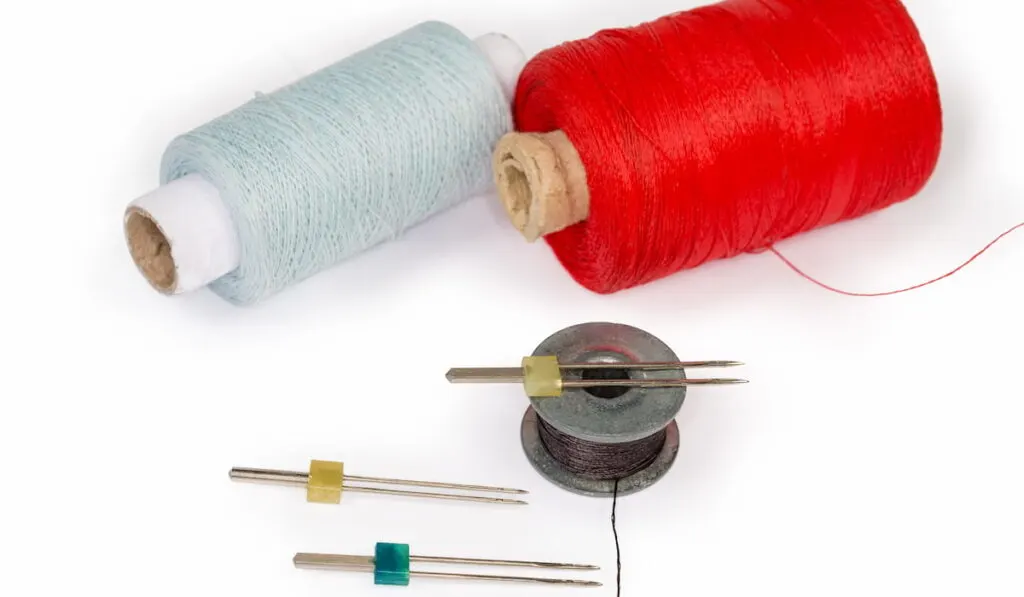
Twin and Triple Needles are used for the same purposes – pin tucking, topstitching, and decorative stitching. Not all sewing machines support these types of needles, so confirm before you get them.
Embroidery Needles
This type of needles have wide eyes, so threads such as polyester, rayon, and cotton can run through the needle easily. Embroidery needles come with a special type of scarf that reduces the chances of having missed stitches.
Hand Sewing Needles
Hand sewing needles come in handy when you have to create finishes you can’t create with your machine.
Sharps Needles
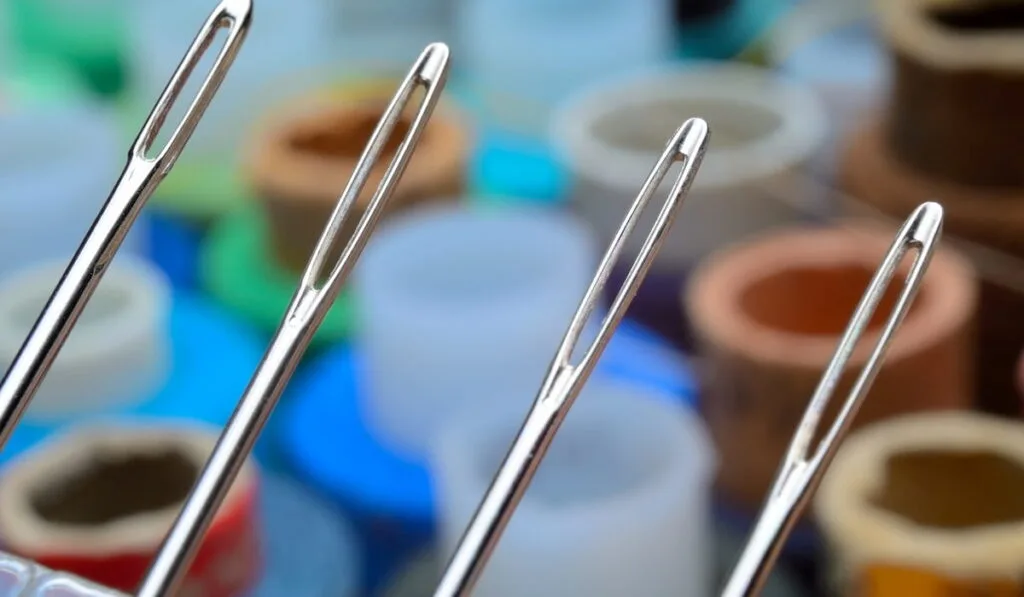
Sharps are like universal needles because they are suitable for many purposes too. They have sharp points, round eyes, and are quite thin.
Darning Needles
They have long shafts, long eyes, and sharp points. Darning needles are used for fixing woven fabrics.
Milliners
Milliners are also called straws. They are very long, have sharp points, and small rounded eyes. While they are primarily used for making hats, milliners can also be used for pleating and basting.
Chenille
Chenille needles have very sharp points, and they can also cause damages if used on the wrong fabric. It is great for decorating fleece and heavy fabrics.
Tapestry Needles
Tapestry needles are similar to chenille, but their points are blunt. They have very large eyes and thick shafts.
Tapestry needles are great for needle points, knits, and loose-weave fabrics.
Beading Needles
Beading needles are long and very thin. They are used for sewing beads, pearls, and sequins. Beading needles are very thin, so they may bend frequently when you use them.
Doll Needles
Doll needles are used in making fabric dolls. They are quite similar to upholstery needles, but they are thinner. They come with a very sharp point.
Upholstery
Upholstery needles are similar to doll needles, but they are thicker. In fact, they are thicker than most types of needles.
Upholstery needles are very long and straight. You can use them for sewing mattresses, furniture, and for quilting.
The other types of hand-sewing needles are Embroidery Needles, Ballpoint Needles, Leather, and Quilting Needles. These needle types serve the same function as their sewing-machine equivalent. They also have similar forms.
How to Choose the Right Sewing Needle
When buying a sewing needle, you should consider the following before you make your choice:
- Needle Size
- Type of Fabric
- Type of Thread
- Sewing Technique/Uses of the Needle
As we have discussed in the preceding paragraphs, the different types of needles work well with certain types of fabric and thread. They are also suited for certain sewing techniques. So, when choosing your needle, consider these.
Also, the needle size to choose depends on the thickness of the material you intend to work on. Opt for larger sizes if your material is thick.
Can Machine Needles Be Used in Any Machine?
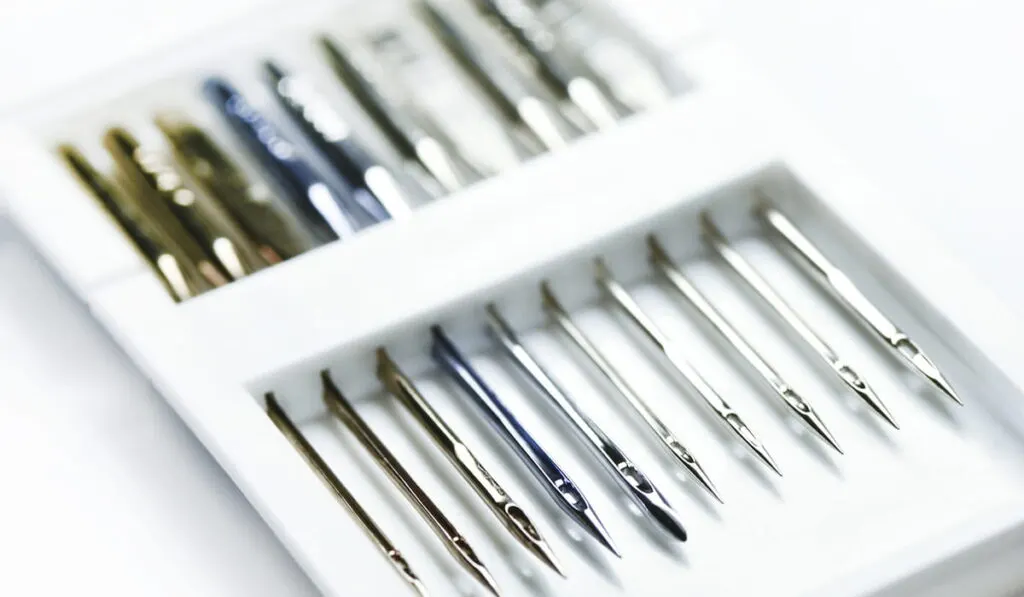
Besides universal needles, machine needles cannot be used in any machine. Some types of needles are not supported by all sewing machines. You can confirm the type of needles your machine supports from the manual.
Whenever you’re buying machine needles, let the retailer know the brand and model of your machine so they can give you what works.
Conclusion
Apart from universal needles, sewing needles are not universal. Some needles might work across some brands and models, but they may not work with all types of sewing machines.
The best thing to do when buying a new needle is to specify the model and brand of your sewing machine.
